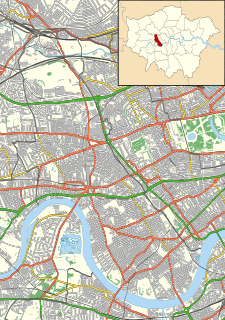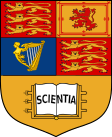Charing Cross Hospital
| Charing Cross Hospital | |
|---|---|
| Imperial College Healthcare NHS Trust | |
 Main hospital building | |
| Geography | |
| Location | Fulham Palace Road, Hammersmith, London, England |
| Coordinates | 51°29′14″N 0°13′10″W / 51.4871°N 0.2195°W |
| Organisation | |
| Care system | National Health Service |
| Type | Teaching |
| Affiliated university | Imperial College London |
| Services | |
| Emergency department | Yes |
| Beds | 511 |
| History | |
| Opened | 1818 (as the West London Infirmary, renamed Charing Cross in 1827) |
| Links | |
| Website | www |
| Lists | Hospitals in England |
Charing Cross Hospital is an acute general teaching hospital located in Hammersmith, London, United Kingdom. The present hospital was opened in 1973, although it was originally established in 1818, approximately five miles east, in central London.
It is part of Imperial College Healthcare NHS Trust and is a teaching hospital of the Imperial College School of Medicine. It is a tertiary referral centre for neurosurgery, and is a national centre of excellence for gestational trophoblastic disease. It currently houses the serious injuries centre for West London.[1] In recent times, the hospital has pioneered the clinical use of CT scanning.
The hospital is host to the West London Neuroscience Centre. In addition, a day surgery unit, the Riverside Wing, was recently added. The West London Mental Health NHS Trust also has buildings on site.[2] The hospital hosts the largest and oldest gender identity clinic in the country, with 150 operations performed annually.[3]
History
19th century


In 1818, Dr. Benjamin Golding established the 'West London Infirmary and Dispensary' at 16 Suffolk Street, behind the Haymarket Theatre. The infirmary had been the dream of Dr. Golding, who wanted to establish a place of healing for the poor. The then Duke of York and Albany was asked to become patron; he accepted, and the hospital was thenceforth known as the Royal West London Infirmary. Following this, the then-Duchess of York and Albany and Duke of Cambridge also became patrons.[4]
In 1821, the infirmary was reaching capacity, treating nearly 10,000 patients a year, so a new site was found, at 28 Villiers Street, near Charing Cross in the heart of the metropolis. The infirmary had room for twelve beds. Shortly afterwards, a plan was put in place to establish a medical school alongside the infirmary. In 1829, the Charing Cross Hospital Medical School was recognised by the newly founded University of London though the school had been training doctors since 1822. Over the years, the list of benefactors and patrons grew, including many from the Royal Family.[4]
In 1827, the name of the Royal West London Infirmary was changed to the more appropriate 'Charing Cross Hospital'. Plans were drawn up by architect Decimus Burton in 1830 and a site was found, just off the Strand (at what is today Agar Street). On 15 September 1831 the foundation stone was laid by the Duke of Sussex. The first completed ward was named after the daughter of the Duchess of Kent, Princess Victoria, who eventually became Queen Victoria. The principal ward for men was named Golding Ward, after the founder. The hospital itself was completed in January 1834, at a total cost of £20,000, and in October of that year, the 22 medical students were transferred from Villiers Street to the new building.[4]
The hospital and medical school continued to expand. When King's College London opened, it needed a medical school and offered Charing Cross a substantial amount of money to train their students. Dr Golding was opposed to the idea and in 1839, after several years of negotiation, King's College decided to set up their own medical school. During those years, the school saw difficult times, and the number of students enrolling plummeted. By 1840, faith in the school had been restored and the number of students increased dramatically; however, Dr. Golding suffered a stroke.[4]
By 1854 the hospital was flourishing and the top floor, which had been left as an empty shell, was completed. In 1856 Dr. Golding retired as Director of Charing Cross Hospital Medical School. The hospital encountered hard times after several new hospitals, with larger medical schools, were established in central London.[4] However, Charing Cross Hospital weathered the storm: in 1866 it had professional nursing staff, and the hospital was enlarged several times over the next few years – in fact, after a major rebuild in 1877 the hospital had doubled in size.[4]
20th century


The hospital was further extended in 1902.[4] In 1926, the Royal Westminster Ophthalmic Hospital was merged with Charing Cross Hospital.[4] With the advent of the Blitz in 1940, the hospital staff, students, equipment and patients were moved to Chaulden House, Boxmoor, Hertfordshire. In 1947, the hospital moved back to Charing Cross.[5]
After the Second World War it was decided to relocate the hospital away from central London. Several sites were considered including a large site at Northwick Park in Harrow. However, the University of London deemed that they would not be able to remain affiliated with the hospital should it move there, and the site was handed over to the Ministry of Health, who developed it into the present Northwick Park Hospital.[4]
In 1957 a link was proposed with Fulham and West London Hospitals. The proposal was controversial, as the residents of Fulham wanted their existing hospital to be redeveloped not taken over. A public meeting was set up with the Mayor of Fulham, and the Chairman of the hospital, Lord Inman, explained that the decision was made by the Ministry of Health, and that a new hospital would be well equipped and provide a full service. This allayed most people's fears, and the new Charing Cross Hospital, located on the site of the former Fulham Hospital, on Fulham Palace Road, was inaugurated by the Queen on 22 May 1973. The cost of building the new hospital was £15m—a staggering amount at the time. Designed by Ralph Tubbs, it consisted of a fifteen-storey building in the shape of a cross, along with several lower-level buildings. The design was notable for the lack of lifts to meet the capacity required to move patients around in their beds. Porters often waited 1–2 hours trying to get patients from wards to X-ray and back. Three high-rise residential blocks were built to house medical staff, nurses and medical students—called Golding, Parsons and Cliff houses, respectively. Despite the move, the hospital kept the name 'Charing Cross'; at first it was called 'Charing Cross Hospital, Fulham' but eventually the 'Fulham' part was dropped.[4]
The Charing Cross Hospital building in Agar Street (a Grade II listed building since 1970)[6] was converted for use in the 1990s and became Charing Cross police station.[7]
Notable alumni

The following are notable alumni:
- David Livingstone, who qualified as a doctor at the hospital but went on to be a famous explorer.[8]
- Thomas Huxley, who qualified as a doctor at the hospital and whose works include 'Zoological Evidences of Man's Place in Nature' and 'Evolution and Ethics'.[9]
- John Astley Bloxam, a pioneering surgeon at the hospital who, according to the Royal College of Surgeons, "excelled in the plastic surgery necessary to repair the noses and lips of those who had been the subjects of syphilitic ulceration".[10]
- Henry Hyde Salter, a physician at the hospital who extensively described Asthma.[11]
- Viscount Addison, who worked at the hospital and is accredited with naming 'Addison's transpyloric plane', a part of the human body used as a surgical landmark.[12]
- Dr Herbert Barrie, a consultant pediatrician at the hospital who developed one of the first special care baby units in London[13] and the country’s first neonatal ambulance.[14]
Medical school

Charing Cross Hospital Medical School merged with Westminster Hospital Medical School to form Charing Cross and Westminster Medical School in 1984. Charing Cross and Westminster Medical School was itself integrated into Imperial College London in 1997. The Reynolds Building (built for Charing Cross and Westminster Medical School in 1976),[15] lies adjacent to the hospital within the campus and is used extensively by Imperial College School of Medicine.[16]
Maggie's Centre
On 29 April 2008, Maggie's Centre was opened by Nigella Lawson and Sarah Brown. This support centre is available for anyone who is affected by cancer in London.[17] In 2009, the centre was visited by Michelle Obama[18] and in October was given the 2009 Stirling Prize from the Royal Institute of British Architects.[19]
See also
References
- ^ Charing Cross Hospital – NHS Choices
- ^ Charing Cross Hospital – Imperial College Healthcare NHS Trust
- ^ Charing Cross Hospital | Gender Surgery – Imperial College Healthcare NHS Trust
- ^ a b c d e f g h i j The Two Pillars of Charing Cross: The Story of a Famous Hospital by R.J. Minney. Published by Cassell London 1967.
- ^ The Charing Cross Hospital and Medical School, London, UK
- ^ Historic England. "Former Charing Cross Hospital (East Side) (1066516)". National Heritage List for England. Retrieved 4 December 2018.
- ^ "Charing Cross Hospital". Lost Hospitals of London. Retrieved 4 December 2018.
- ^ "Livingstone's Medical Education". Livingstone on line. Retrieved 12 May 2018.
- ^ "Huxley, Thomas Henry (1825 - 1895)". Royal College of Surgeons. Retrieved 12 May 2018.
- ^ "Bloxham, John Astley (1843 - 1926)". Royal College of Surgeons. Retrieved 12 May 2018.
- ^ Sakula, A (1985). "Henry Hyde Salter (1823–71): a biographical sketch". Thorax. 40 (12): 887–8. doi:10.1136/thx.40.12.887. PMC 460219. PMID 3913047.
- ^ "Christopher, (Sir) Viscount Addison of Stallingborough Addison". Royal College of Physicians. Retrieved 12 May 2018.
- ^ Barrie, Michael (8 May 2017). "Herbert Barrie". BMJ. 357: j2187. doi:10.1136/bmj.j2187. ISSN 0959-8138. PMID 28483973.
- ^ "Dr Herbert Barrie". The Times. 8 May 2017. ISSN 0140-0460. Retrieved 12 March 2018.
- ^ "Charing Cross and Westminster Medical School". JISC. Retrieved 12 May 2018.
- ^ "Open Tech 2005". Open Tech. Retrieved 12 May 2018.
- ^ Maggies's Cancer Caring Centres: Maggies's London
- ^ Maggies's Cancer Caring Centres
- ^ Maggie's Centre Wins Stirling Prize – Londonist
External links
- Imperial College Healthcare
- NHS hospitals in London
- Hospital buildings completed in 1834
- Decimus Burton buildings
- Hospital buildings completed in 1973
- Health in the London Borough of Hammersmith and Fulham
- Buildings and structures in the London Borough of Hammersmith and Fulham
- Teaching hospitals in London
- Hospitals established in 1818
- 1818 establishments in England
- Physicians of Charing Cross Hospital


